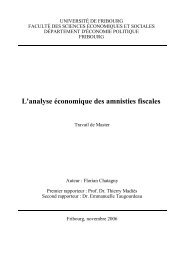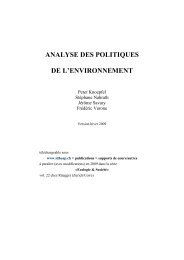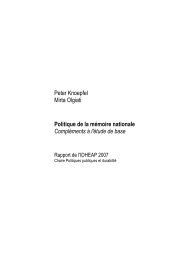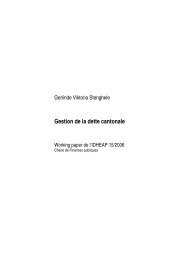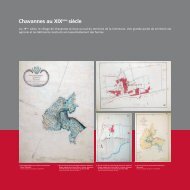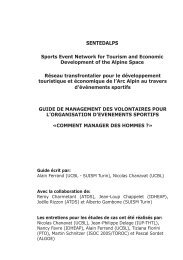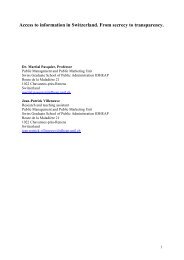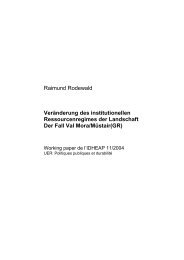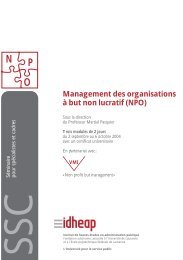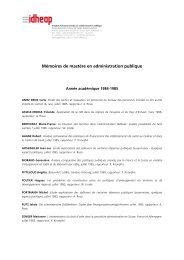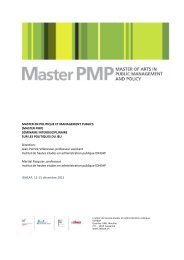Voting advice applications and party choice: evidence from ...
Voting advice applications and party choice: evidence from ...
Voting advice applications and party choice: evidence from ...
You also want an ePaper? Increase the reach of your titles
YUMPU automatically turns print PDFs into web optimized ePapers that Google loves.
380 A. Ladner, J. Fivaz <strong>and</strong> J. Pianzola<br />
Furthermore, the model indicates that voters who were surprised by the voting<br />
recommendations they received were more likely to swing-vote compared to those who<br />
were not surprised by them. The probability of swing-voting, however, significantly<br />
increases only for those who were very surprised by the voting recommendations, but not<br />
so for those who were only somewhat surprised by it. Although still a far stretch, this<br />
result suggests that voters who were particularly surprised by the recommended parties<br />
<strong>and</strong> c<strong>and</strong>idates they received might have been inclined to adapt their initial vote <strong>choice</strong>s<br />
accordingly.<br />
As expected, voters in the middle of the political spectrum <strong>and</strong> voters with multiple<br />
vote propensities are more likely to swing vote, while <strong>party</strong> attachment decreases the<br />
likelihood of swing-voting. The number of c<strong>and</strong>idates running per seat also matters, with<br />
higher competition increasing the likelihood of swing-voting among voters in that<br />
constituency. The remaining socio-demographic variables are not significant predictors.<br />
Although the explanatory power of the model is rather weak given the model fit<br />
measures, the number of correctly predicted cases based on the model is substantially<br />
higher compared to r<strong>and</strong>om chance (64% vs. 39%). In this paper, we are mainly<br />
interested in detecting theorised implications while being aware that there is still variance<br />
to be explained. In general, we do not make any claims about effects but remain in the<br />
realm of predictions. The data at h<strong>and</strong> stems <strong>from</strong> a non-r<strong>and</strong>om, self-selected sample of<br />
smartvote users, limiting any sort of interpretation to that specific sample. To improve<br />
the analysis, experimental data or measures to correct for self-selection need to be<br />
taken; only then can any general claims be made. For now, we acknowledge these<br />
shortcomings.<br />
All things considered, the model supports our assumption that voters see smartvote as<br />
a serious <strong>and</strong> useful tool for their decision-making, one that can affect their actual vote.<br />
Thus, the findings in this section go along with those of the previous section. One<br />
argument that might strengthen our findings is that, due to the definition of swing-voting,<br />
we had to exclude those voters who were not eligible to vote in 2003 (the youngest<br />
users). Since it is this age cohort in particular that uses smartvote most frequently <strong>and</strong> is<br />
also most amenable to the tool, we can expect that an analysis that takes those voters into<br />
account as well finds even stronger support for an influence of the tool on decisionmaking.<br />
Another argument that might weaken our findings is that our specific sample<br />
might lead to such strong results. Chances are that convinced <strong>and</strong> highly enthusiastic<br />
smartvote users might have self-selected themselves into taking our survey; thus, we<br />
report a strong influence of the tool among a strongly influenced sample of smartvote<br />
users. For now, we can conclude only that some young smartvote users <strong>and</strong> those who<br />
were most surprised by the voting recommendations have a higher probability of<br />
changing their vote <strong>choice</strong>s between elections.<br />
6 Party change: winners <strong>and</strong> losers<br />
Since our findings suggest that influenced smartvote users are prone to change their vote<br />
<strong>choice</strong>s, our next <strong>and</strong> last step in this analysis is to take a look at the direction of their<br />
vote change. Table 6 shows the flow of votes between the elections of 2003 <strong>and</strong> 2007 for<br />
those voters who were influenced in their vote <strong>choice</strong>s by smartvote.



